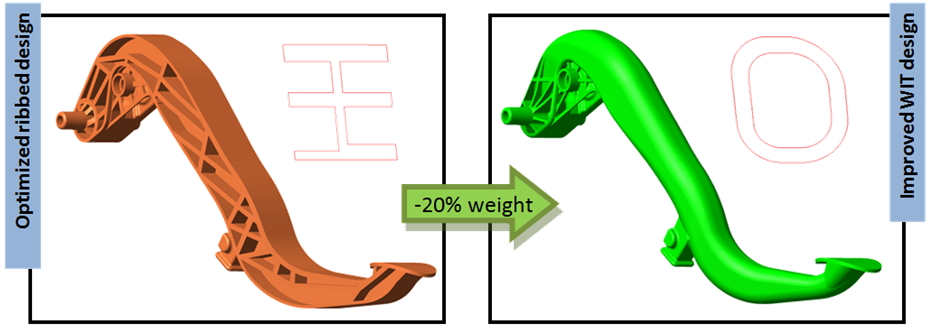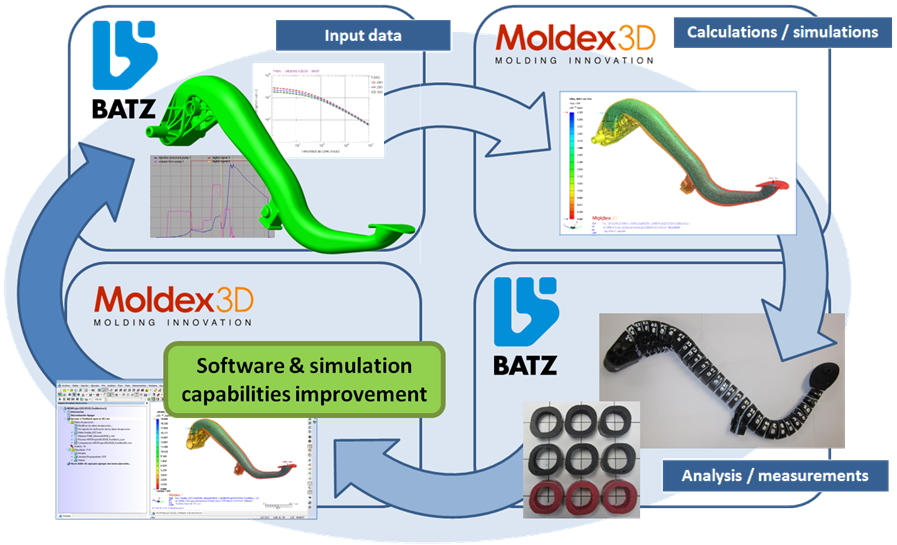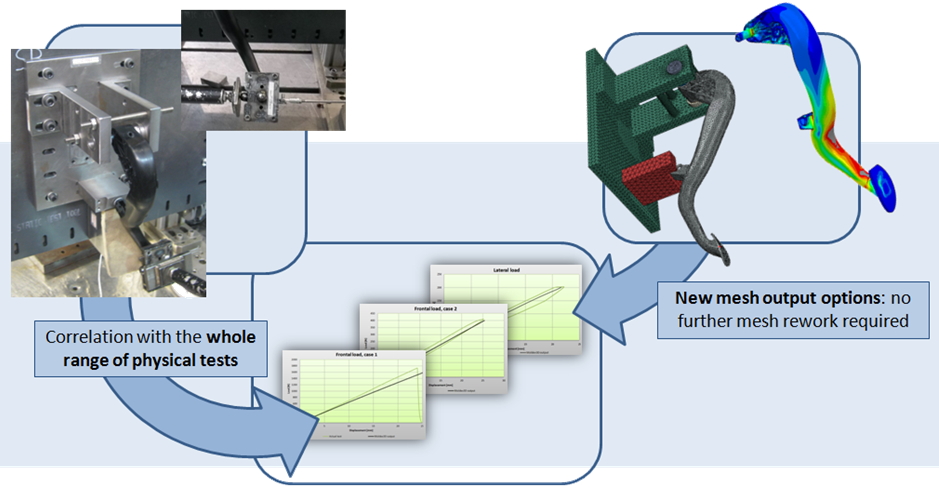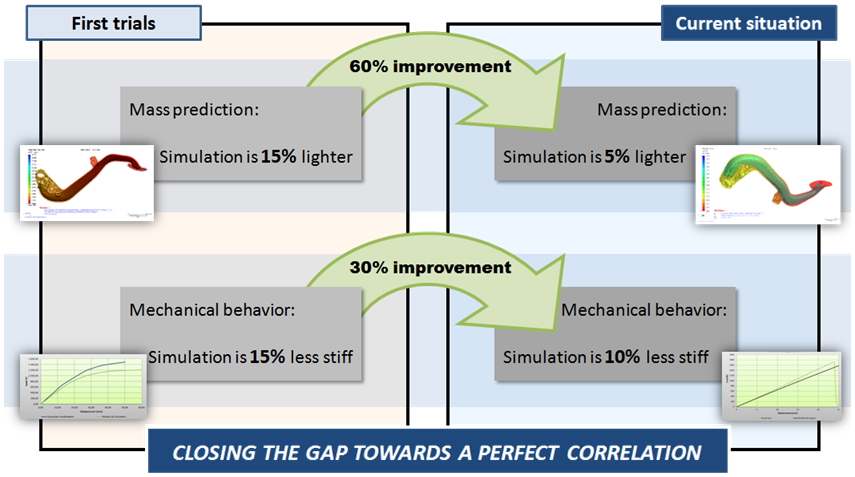Â

- Customer: BATZ S. Coop.
- Industry: Automotive
- Solution: Moldex3D Advanced Package / Water-Assisted Injection Molding Module / Fiber Module / FEA Interface
- Country: Spain
Executive Summary
Water injection technology (WIT) offers major benefits when it comes to cycle time shortening and overall cost reduction. It also makes it possible to do hollow part injection, thus achieving better mechanical performance with less material expenses. But in order to do so, structural behavior of the part, which depends on the residual wall thickness (RWT) distribution, has to be accurately predictable. BATZ and Moldex3D worked jointly to improve WIT simulation module’s performance.
Challenges
- Structurally critical part (clutch pedal)
- Accurate RWT distribution prediction so part development stage can be optimized
- Software fine-tuning for a more accurate process simulation
- Results exportation in order to perform the structural analysis
- Correlation: virtual prototype vs. actual part
 Solutions
An iterative work-flow including updated input data, injection simulations, thorough physical part inspection and tests, result comparison and software fine-tuning
Values
RWT and mass prediction accuracy was significantly improved and mesh exportation options were added
Case Study
Migrating from steel to plastics has become a global trend in the automotive industry. Fuel consumption economy and increasingly restrictive regulations enforce lightweight design criteria adoption, and plastic materials play an important role in this new scenario. On the other hand, since safety requirements are becoming stricter, these new plastic solutions have to deal with even more demanding mechanical specifications than their formerly metallic counterparts.Â
Pedal modules, and clutch pedals more specifically, are an example of this migration. Back when they were basically a bent thick steel plate, a couple of additional elements had to be welded in order to provide a rotation axis and proper vehicle and user interfaces. Nowadays, pedals not only have to be lighter, but also additional functions such as pedal release systems or sensor interfaces require more complex geometries. In this regard, plastic designs offer a convenient compromise between weight reduction and function integration. Furthermore, since there is usually no need for additional processes such as welding or mechanization, production costs are reduced.
Hence, today plastic clutch pedals are found on most vehicles. In most cases though, they are traditional injection molded parts, with their characteristic geometrical ribbed patterns. In accordance with its lightweight design philosophy, BATZ started implementing topological optimization tools on those geometries in order to achieve further weight reduction. Impressive results were achieved and resulting parts marketed, but this simply wasn’t enough, so BATZ had to go a step further. And this is where WIT comes into play.

Water Injection Technology’s advantages regarding melt cooling properties, cycle time shortening and overall cost reduction are well known. But as structural part developers, what appeals more to BATZ is the possibility of designing hollow plastic parts. Higher moments of inertia can be attained via closed-shaped-sections, thus needing less material to reach same mechanical behavior. However, structural performance is directly related to the Residual Wall Thickness distribution, and a proper prediction of material accumulation is imperative to optimize the part development stage, minimize trials and modifications, reduce material expenses and keep being competitive.
Thanks to its WIT simulation module, Moldex3D offers the opportunity to predict the inner cavity geometry of the part, so structural analysis can be performed accordingly. Back in 2012 both companies agreed to work jointly on fine tuning the software: Moldex3D has the simulation capabilities and BATZ is a convenient industrial partner with a WIT injected part already on production. That being said, a research project was accomplished during the following months. During that time, an iterative process of injection simulations, real part measurements/tests and result correlation analyses were carried out.

BATZ started providing Moldex3D with the current part geometry and input data such as injection parameters and material properties. The injection process was simulated accordingly and BATZ compared the results with a series of thorough real part measurements. Moldex3D gathered this feedback in order to check the deviations and fine tune the solver.
Special attention was paid to the mechanical behavior of the part, since a proper correlation of virtual and physical prototypes is the key for rational cost reduction. At the very beginning, mesh exportation issues required some reworking so the calculations did not take too much time. But as the research project kept going, Moldex3D R12 was released, which incorporated powerful mesh exportation tools. Now, the whole process has become really straightforward and best of all is the fact that total development time was significantly reduced.

This iterative work-flow continued during the following months and the situation greatly improved since early trials. Apart from the aforementioned mesh exportation options, the new kernel performs better than its predecessor too. Joint work between Moldex3D and BATZ has paid off, and now mass prediction accuracy is up to 60% better, which translates into a 30% better structural analysis correlation. All in all, Moldex3D has revealed itself as a key tool for faster, optimized WIT part development.

The Value of Moldex3D
 |
WIT is a terribly promising technology, but in order to be effective, it requires accurate supporting simulations tools like Moldex3D. Â Â Â Â Â Â -Fernando Burguera, Advanced Engineering Manager at BATZ |
Automatic Drill Press,Benchtop Drill Press,Industrial Drilling Machine,Bench Drill Press
Zigong Yibaijie , https://www.oz-yibaijie.com